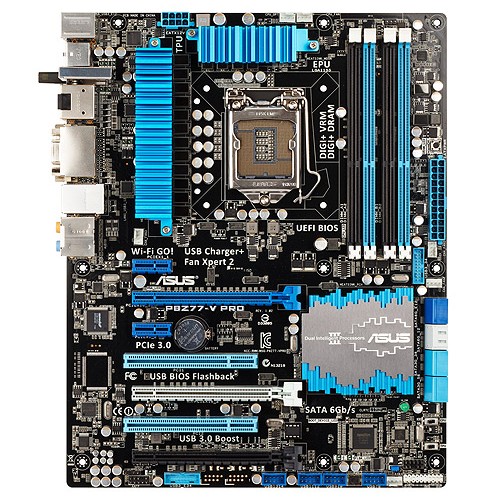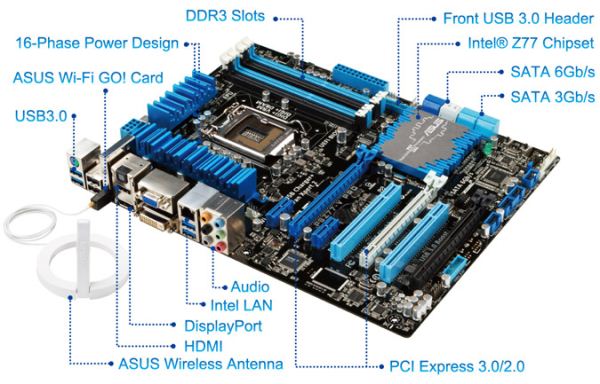Intel Z77 Panther Point Chipset and Motherboard Preview – ASRock, ASUS, Gigabyte, MSI, ECS and Biostar
by Ian Cutress on April 8, 2012 12:00 AM EST- Posted in
- Motherboards
- Intel
- Biostar
- MSI
- Gigabyte
- ASRock
- Asus
- Ivy Bridge
- ECS
- Z77
ASUS P8Z77-V Pro—Visual Inspection
ASUS have a lot to live up to with its Ivy Bridge Pro board. Both the ASUS P8P67 Pro and ASUS P8Z68-V Pro have been top class sellers in their respective chipsets, meaning that ASUS has to deliver. Thankfully, by just looking at the board, it seems that ASUS is keen to innovate and offer a complete package.
Using a 12 + 4 VRM power delivery system, the ASUS P8Z77-V Pro sports a blue and black livery synonymous with their channel / non-ROG products. The VRM heatsinks cover a lot of surface area in their jagged fashion, and around the socket itself, we have access to five main fan headers. Two of these are CPU 4-pin headers just north of the top VRM heatsink, one 4-pin below the left hand side VRM heatsink, and two 4-pin headers below the 24-pin ATX power connector, along with a USB 3.0 port. A sixth fan header (4-pin) is found on the south side of the board.

Above the 24-pin ATX power connector, we find the ASUS MemOK! button, which allows memory recovery to default speeds. Along with the ASRock boards, we have eight SATA ports—four SATA 3 Gbps from the PCH and four SATA 6 Gbps—two from the PCH and two more from an ASMedia controller. Below this are the TPU and EPU switches, designed for enhanced CPU performance and energy saving modes respectively.

Along the bottom of the board is the standard array of a front panel audio header, another USB 3.0 header, USB 2.0 headers, and a front panel header. In terms of PCIe layout, despite there being three full-length PCIe connectors on board, we are only limited to using two for multi-GPU setups. In order, we have a PCIe x1, a PCIe 3.0 x16 (x8 in dual GPU), x1, PCI, PCIe 3.0 x8, PCI, and a PCIe 2.0 x4. Thus in dual GPU mode, similarly to the ASRock Extreme6, we can also add in a PCIe x1 and PCIe x4 card.
The chipset heatsink is indicative of the large but low philosophy of many motherboard manufacturers, hiding away the chipset controller. What is not on these boards, as you may notice, is a combination power/reset pair of buttons, nor a two-digit debug, some of which we used to see on ASUS Pro boards of old. Nevertheless, the ASUS board in return makes up for it on the back IO panel.

On the back panel, we have a combination PS/2 port, two USB 3.0 ports (blue), two USB 2.0 ports (black), an ASUS Wi-Fi GO! Card, optical SPDIF output, HDMI, DisplayPort, D-Sub, DVI-D, gigabit Ethernet, two more USB 3.0 ports in blue, and standard audio headers.
This means that rather than add in a WiFi module on the board, or use up a mini-PCIe slot with wifi, we have a slot in order to add a WiFi module. This can be in 2.4 GHz or 5 GHz mode, and updateable as WiFi standards change. This all comes as part of the package, with magnetic wireless antenna to attach to the case.
Board Features
| ASUS P8Z77-V Pro | |
| Size | ATX |
| CPU Interface | LGA-1155 |
| Chipset | Intel Z77 |
| Power Delivery | 12 + 4 |
| Memory Slots |
Four DDR3 DIMM slots supporting up to 32 GB Up to Dual Channel |
| Video Outputs | DisplayPort, HDMI 1.4a, DVI-D, D-Sub |
| Onboard LAN | Intel 82579V |
| Onboard Audio | Realtek ALC892 |
| Expansion Slots |
2 x PCIe x16 Gen3 (x16, x8/8) 1 x PCIe x16 Gen2 (x4) 2 x PCIe x1 Gen2 2 x PCI |
| Onboard SATA/RAID |
2 x SATA 6 Gbps (PCH), Support for RAID 0, 1, 5, 10 2 x SATA 6 Gbps (ASMedia) 4 x SATA 3 Gbps (PCH), Support for RAID 0, 1, 5, 10 |
| USB |
Four USB 3.0 at rear (2 PCH, 2 ASMedia) Two USB 3.0 headers on board (PCH, ASMedia) Ten USB 2.0 (2 back panel, 8 on board) |
| Onboard |
4 x SATA 6 Gbps 4 x SATA 3 Gbps 2 x USB 3.0 Headers 4 x USB 2.0 Headers 6 x Fan Headers 1 x SPDIF Header 1 x Front Panel Audio Header MemOK! Button TPU/EPU Switches USB Flashback Button |
| Power Connectors |
1 x 24-pin ATX connector 1 x 8-pin 12V connector |
| Fan Headers |
1 x CPU Fan Header (4-pin) 4 x CHA Fan Headers 1 x OPT Fan Header |
| IO Panel |
1 x PS/2 Combo Port 1 x DisplayPort 1 x HDMI 1.4a 1 x DVI-D 1 x D-Sub 1 x Gigabit Ethernet 4 x USB 3.0 2 x USB 2.0 1 x Optical SPDIF 1 x WLAN Connector 6 x Audio Jacks |
| Warranty Period | 3 Years |
| Product Page | Link |
ASUS as a direct standard are now placing Intel NICs on all their channel motherboards. This is a result of a significant number of their user base requesting them over the Realtek solutions. Also to note are a total of six USB 3.0 on board, two on the back panel and four from internal headers. These USB 3.0 ports can take advantage of the improved UASP USB 3.0 protocol using appropriate hardware and some ASUS software. As always, we expect ASUS fan control of the six headers to be top notch.











145 Comments
View All Comments
ASUSTechMKT - Monday, April 9, 2012 - link
ASMedia does not produce or design a bluetooth controller. Additionally you are correct in that add in controllers do offer support for specialized modes of operation.functionality ( like charging )ASUSTechMKT - Monday, April 9, 2012 - link
the Intel controller under Windows 7 does not offer operating in UASP mode. With UASP the ASMedia add in controller can provide superior performance especially in queue depth. The USB3 Boost package is offered for both the Intel controller and the ASMedia ( Intel support change from BOT mode to SCSI ( Turbo mode ) and the ASMedia controller of support for BOT, SCSI ( Turbo ) as well UASP.MrMaestro - Sunday, April 8, 2012 - link
I didn't know a motherboard could be kitsch until I saw the ECS.XSCounter - Sunday, April 8, 2012 - link
P8Z77-M is the one I am waiting for for my Micro ATX build. It has no those xtra useless controllers which are all gonna be inferior to native Intel ones. So won't overpaying anything.However, I am planning to overclock so I wish to know how it will perform in this regard! Hoping to see these ASUS Micro ATX boards on Anandtech asap :)
http://uk.asus.com/Motherboards/Intel_Socket_1155/...
ASUSTechMKT - Monday, April 9, 2012 - link
It features a Digi+ VRM with robust VRM components overall in our testing the -M Pro provide comparable scaling to that of our standard board. You will see this information from ASUS soon. Solid board !Lonyo - Sunday, April 8, 2012 - link
What happened to the boards with 10 SATA ports?There were some from tradeshows earlier in the year, but none listed here (apart from the one with 8 + 2 eSATA).
Obviously this isn't a comprehensive lineup, but most of these seem to be fairly high end boards, yet no 10 SATA ports.
ASUSTechMKT - Monday, April 9, 2012 - link
Very few users use this many ports it makes sense more to prioritize expansion lane support to add ons that will be used. Keep in mind even with a board with that number of ports you may not actually be able to have that usable bandwidth.Should you really need that many you should consider an add on controller card. Things like SATA ports while important are not the only way to distinguish true attention to design in higher end boards.
aranyagag - Sunday, April 8, 2012 - link
"four SATA 6 Gbps also from the PCH," shouldn't that be sata 3 gbpsin the msi gd65 board
ConVuzius - Sunday, April 8, 2012 - link
The article says Virtu MVP has an i-Mode and a d-Mode, but which one is the better one? I kinda didnt get the difference, except where you connect your display.Ryan Smith - Sunday, April 8, 2012 - link
For regular Virtu, d-Mode is the mode that was better from a performance perspective, since at times performance under i-Mode dipped due to having to send frames out to the iGPU.For MVP, there's not going to be all that much of a difference. Regardless of the mode used Virtual V-Sync needs frames passed from the dGPU to the iGPU. The only difference is which display output is used, since a copy of the frame is on both GPUs (i.e. while you have to send frames to the iGPU, you don't have to send them back even in d-Mode).